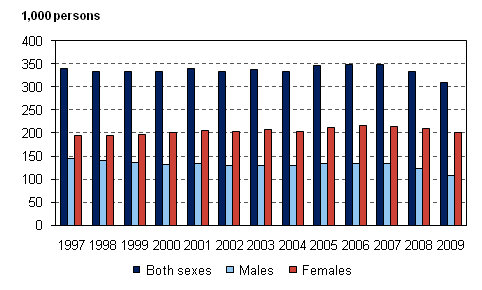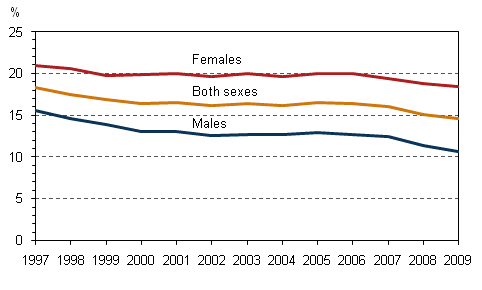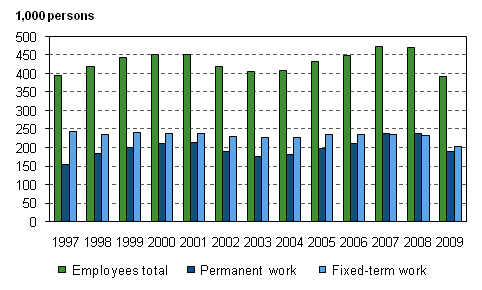1. Fixed-term employment relationships decreased in 2009
The general worsening of the employment situation in 2009 was also reflected in fixed-term employment relationships. A total of 310,000 employees worked in fixed-term employment relationships in 2009. This was 22,000 persons fewer than in the previous year. There were altogether 2,123,000 employees in Finland in 2009, which was 84,000 fewer than in 2008.
Approximately 15 per cent of employees worked in fixed-term employment relationships in 2009. The share was slightly smaller than in 2008. In 2009, the number of employees with fixed-term contracts was the lowest since 1997, or the starting year of a fully comparable times series. The share of fixed-term employees among all employees was also at its lowest in 2009. (Figures 1 and 2).
Figure 1. Number of fixed-term employees aged 15–74 by sex in 1997–2009

Fixed-term employment is more usual among women than men. In 2009, altogether 201,000 of all fixed-term employees were women while 109,000 were men. The share of fixed-term employees was around 18 per cent among female employees and around 11 per cent among male employees. Both the number and the share of persons employed fixed-term decreased among both genders. Especially male employees’ fixed-term employment relationships decreased from the previous year in 2009.
Figure 2. Share of fixed-term employees among employees aged 15–74 by sex in 1997–2009, %

Fixed-term employment shows clear seasonal fluctuation, for the number of fixed-term employment relationships always goes up in the second and third quarters of the year. In 2009, the reduction in the number of fixed-term employment contracts appears to have mainly affected summer jobs, as there were 37,000 fewer fixed-term employees in the second and third quarters of 2009 than in the respective quarters of the previous year.
Fixed-term employment relationships decreased mainly in the private sector (-21,000) whereas in the public sector their number remained almost unchanged. Fixed-term employment relationships diminished most in the industry of manufacturing where their number was 12,000 lower in 2009 than in the previous year. Fixed-term employment contracts also decreased in the industries of construction, and wholesale and retail trade. Health and social work was the only industry where the number of fixed-term employment relationships increased.
1.1 Two out of three fixed-term employees could not find permanent work
To an employee, working fixed-term can be either a desired or involuntary form of employment. Approximately one-quarter of fixed-term employees did not want a permanent job. The majority of them were aged between 15 and 24. Summer workers are a typical group of persons working voluntarily in fixed-term jobs.
However, a more common reason for working in a fixed-term employment relationship is that permanent work cannot be found. In 2009, the lack of permanent work was the reason why around 67 per cent of fixed-term employees worked in fixed-term jobs. In 2009, there were 209,000 fixed-term employees on the labour market who had not found a permanent job even though they would have wanted one. Of them, 137,000 were women and 72,000 men. Involuntary working under fixed-term contracts increases with age.
The number of persons working involuntarily in fixed-term jobs grew by 10,000 from 2008 to 2009. Over the same time period the number of fixed-term employees whom fixed-term employment suited decreased by 16,000. Thus, on the one hand the weakening of the employment situation was seen as reduced hiring of summer workers and, on the other, as increased discretion in hiring people for permanent jobs.
1.2 Around one-half of new employment contracts were fixed-term
New employment contracts with a duration of under one year numbered 392,000 in 2009. This was 78,000 fewer than in 2008. Just over one-half of all new employment contracts were fixed-term. In 2007 and 2008, the share of permanent contracts of all new employment contracts was exceptionally larger than that of fixed-term contracts. (Figure 3)
Figure 3. New employment contracts with a duration of under one year of employees aged 15–74 in 1997–2009

There is a clear difference between women and men in whether a new employment relationship is fixed-term or permanent. In 2009, approximately 58 per cent of women’s and around 44 per cent of men’s new employment contracts were fixed-term. A larger proportion of men’s new employment contracts have been permanent almost throughout the examination period since 1997. By contrast, a clearly larger proportion of women’s new employment contracts have been fixed-term over the same time period.
Source: Labour force survey 2009. Statistics Finland
Inquiries: Anna Pärnänen (09) 1734 2607, Päivi Keinänen (09) 1734 3416, tyovoimatutkimus@stat.fi
Director in charge: Riitta Harala
Updated 1.6.2010
Official Statistics of Finland (OSF):
Labour force survey [e-publication].
ISSN=1798-7857. 15 2009,
1. Fixed-term employment relationships decreased in 2009
. Helsinki: Statistics Finland [referred: 18.12.2025].
Access method: http://stat.fi/til/tyti/2009/15/tyti_2009_15_2010-06-01_kat_001_en.html

